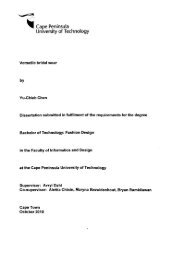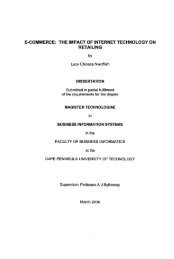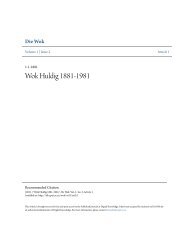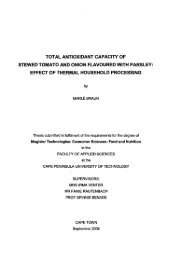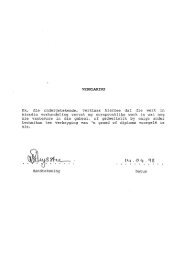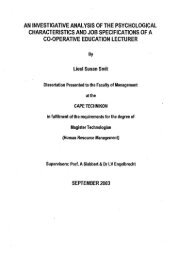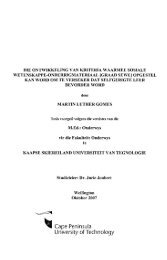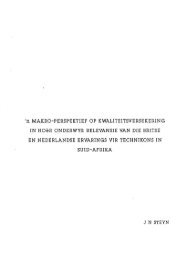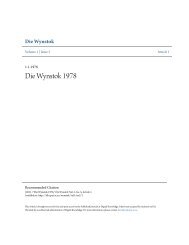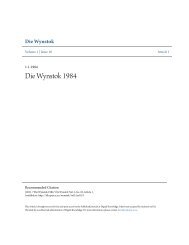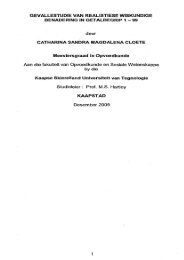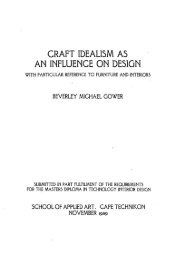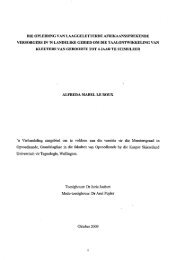the effect of the particle size distribution on non-newtonian turbulent ...
the effect of the particle size distribution on non-newtonian turbulent ...
the effect of the particle size distribution on non-newtonian turbulent ...
Create successful ePaper yourself
Turn your PDF publications into a flip-book with our unique Google optimized e-Paper software.
Chapter 3 Experimental Work Page 3.19<br />
3.5.2 Solids Relative Density<br />
The relative density <str<strong>on</strong>g>of</str<strong>on</strong>g> <str<strong>on</strong>g>the</str<strong>on</strong>g> solids (S,) is determined using test method 6B for fine grained<br />
soils from BS 1377 (1975).<br />
3.5.3 Slurry Temperature<br />
A mercury <str<strong>on</strong>g>the</str<strong>on</strong>g>rmometer was used to measure <str<strong>on</strong>g>the</str<strong>on</strong>g> temperature <str<strong>on</strong>g>of</str<strong>on</strong>g> <str<strong>on</strong>g>the</str<strong>on</strong>g> slurry in <str<strong>on</strong>g>the</str<strong>on</strong>g> hopper.<br />
The temperature very rarely went above 20°C, with a temperature <str<strong>on</strong>g>of</str<strong>on</strong>g> between 19°C and<br />
20°C being <str<strong>on</strong>g>the</str<strong>on</strong>g> norm. A rise <str<strong>on</strong>g>of</str<strong>on</strong>g>.approximately 2°C is usually experienced during a test run.<br />
If a temperature rise exceeding 2°C is experienced, data at <str<strong>on</strong>g>the</str<strong>on</strong>g> extreme temperatures is<br />
compared to detect for any temperature <str<strong>on</strong>g>effect</str<strong>on</strong>g>s (Slatter, 1994).<br />
3.5.4. Particle Size Distributi<strong>on</strong><br />
The ASTM (American Standard Testing Method), which is recognized worldwide, was used<br />
to determine <str<strong>on</strong>g>the</str<strong>on</strong>g> <str<strong>on</strong>g>particle</str<strong>on</strong>g> <str<strong>on</strong>g>size</str<strong>on</strong>g> <str<strong>on</strong>g>distributi<strong>on</strong></str<strong>on</strong>g>s and were c<strong>on</strong>ducted at Gibbs Africa laboratories.<br />
In this procedure a sample <str<strong>on</strong>g>of</str<strong>on</strong>g> slurry is thoroughly dried and <str<strong>on</strong>g>the</str<strong>on</strong>g> courser <str<strong>on</strong>g>particle</str<strong>on</strong>g>s are screened<br />
to determine <str<strong>on</strong>g>the</str<strong>on</strong>g> <str<strong>on</strong>g>distributi<strong>on</strong></str<strong>on</strong>g>. The <str<strong>on</strong>g>distributi<strong>on</strong></str<strong>on</strong>g> <str<strong>on</strong>g>of</str<strong>on</strong>g> finer <str<strong>on</strong>g>particle</str<strong>on</strong>g>s is determined using a<br />
hydrometer. The <str<strong>on</strong>g>particle</str<strong>on</strong>g> <str<strong>on</strong>g>size</str<strong>on</strong>g> <str<strong>on</strong>g>distributi<strong>on</strong></str<strong>on</strong>g>s for <str<strong>on</strong>g>the</str<strong>on</strong>g> kaolin clay test sets however, were<br />
determined using <str<strong>on</strong>g>the</str<strong>on</strong>g> Malvern 2600/3600 Particle Sizer VF.6 instrument, which if used<br />
correctly produces more accurate results for finer material (Roberts<strong>on</strong>, 1996). Ideally it<br />
would have been preferable to use <strong>on</strong>ly <strong>on</strong>e PSD method however, <str<strong>on</strong>g>the</str<strong>on</strong>g> testing method <str<strong>on</strong>g>of</str<strong>on</strong>g> <str<strong>on</strong>g>the</str<strong>on</strong>g><br />
Malvern instrument was not suitable for determining <str<strong>on</strong>g>the</str<strong>on</strong>g> courser <str<strong>on</strong>g>particle</str<strong>on</strong>g>s <str<strong>on</strong>g>of</str<strong>on</strong>g> <str<strong>on</strong>g>the</str<strong>on</strong>g> slurry and<br />
hence it was decided to use <str<strong>on</strong>g>the</str<strong>on</strong>g> ASTM method for Mixture 1 and Mixture 2 and <str<strong>on</strong>g>the</str<strong>on</strong>g> Malvern<br />
Instrument for <str<strong>on</strong>g>the</str<strong>on</strong>g> finer kaolin clay <str<strong>on</strong>g>particle</str<strong>on</strong>g>s. The <str<strong>on</strong>g>particle</str<strong>on</strong>g> <str<strong>on</strong>g>size</str<strong>on</strong>g> <str<strong>on</strong>g>distributi<strong>on</strong></str<strong>on</strong>g>s are presented<br />
in Appendix A.<br />
Any comparis<strong>on</strong> <str<strong>on</strong>g>of</str<strong>on</strong>g> <str<strong>on</strong>g>particle</str<strong>on</strong>g> <str<strong>on</strong>g>size</str<strong>on</strong>g> <str<strong>on</strong>g>distributi<strong>on</strong></str<strong>on</strong>g>s should be undertaken with cauti<strong>on</strong> as those<br />
prodUced by methods o<str<strong>on</strong>g>the</str<strong>on</strong>g>r than <str<strong>on</strong>g>the</str<strong>on</strong>g> ASTM or <str<strong>on</strong>g>the</str<strong>on</strong>g> Malvern 2600/3600 Particle Sizer VF.6<br />
Instrument may not necessarily agree. An example <str<strong>on</strong>g>of</str<strong>on</strong>g> this can be seen in Figure 3.15 where<br />
<str<strong>on</strong>g>the</str<strong>on</strong>g> same slurry (mixture <str<strong>on</strong>g>of</str<strong>on</strong>g> kaolin, rock flour and sand) used for <str<strong>on</strong>g>the</str<strong>on</strong>g> ASTM, was used <strong>on</strong><br />
<str<strong>on</strong>g>the</str<strong>on</strong>g> Malvern instrument for <str<strong>on</strong>g>particle</str<strong>on</strong>g> <str<strong>on</strong>g>size</str<strong>on</strong>g> <str<strong>on</strong>g>distributi<strong>on</strong></str<strong>on</strong>g> determjnati<strong>on</strong>s. As can be seen from



